- Salsify
Taxobox
name = Goatsbeards

image_width = 250px
image_caption = Purple Salsify, "Tragopogon porrifolius"
regnum =Plant ae
divisio = Magnoliophyta
classis = Magnoliopsida
ordo =Asterales
familia =Asteraceae
tribus =Cichorieae
genus = "Tragopogon"
genus_authority = L.
subdivision_ranks = Species
subdivision = about 45, including:
"Tragopogon coloratus "
"Tragopogon crocifolius "
"Tragopogon cupani "
"Tragopogon dubius"
"Tragopogon floccosus"
"Tragopogon gracilis "
"Tragopogon mirabilis"
"Tragopogon mirus"
"Tragopogon miscellus"
"Tragopogon porrifolius"
"Tragopogon pratensis"
"Tragopogon X crantzii"
"Tragopogon X neohybridus": "See alsoAruncus , which is also known as "goatsbeard"."The Goatsbeards or Salsifies are the
genus "Tragopogon" offlowering plant s within the familyAsteraceae . They include thevegetable called salsify as well as a number of common wild flowers, some of which are usually regarded asweed s.Goatsbeards are
forb s growing as biennial orperennial plant s. They have a strong taproot and milky sap. They generally have few branches, and those there are tend to be upright. Their leaves are somewhat grass-like. Flower colour varies within the genus, with some yellow species, and some bronze or purple. Seeds are borne in a globe like that of adandelion but larger, and are dispersed by the wind.The goatsbeards are natives of
Europe andAsia , but several species have been introduced intoNorth America andAustralia and have spread widely there.Some of the more common species of "Tragopogon" are known, in the regions where they are most common, by the common names "goat's beard", "goatsbeard", "salsify" or "common salsify", without further qualification. These names are therefore inherently ambiguous, and best avoided, or reserved for the genus collectively. In the species list below, the first common name given is the one that seems to be most widely used for that species and is not in significant use for any other species.
The vegetable called salsify is usually the root of
Purple Salsify , "Tragopogon porrifolius"; the root is described as having the taste ofoyster s (hence the alternative common name "Oyster Plant" for some species in this genus), but more insipid with a touch of sweetness. The young shoots of Purple Salsify can also be eaten. Other species are also used in the same way, including the Black orSpanish Salsify , "Scorzonera hispanica", which is closely related though not a member of the genus "Tragopogon".The rise of new species
Goatsbeard are one example where
hybrid speciation has been observed. In the early 1900s, humans introduced three species of goatsbeard into North America. Thesespecies , theWestern Salsify ("T. dubius"), theMeadow Salsify ("T. pratensis"), and theOyster Plant ("T. porrifolius"), are now common weeds in urban wastelands. In the 1950s, botanists found two new species in the regions ofIdaho andWashington , where the three already known species overlapped. One new species, "Tragopogon miscellus ", is atetraploid hybrid of "T. dubius" and "T. pratensis". The other species, "Tragopogon mirus ", is also an allopolyploid, but its ancestors were "T. dubius" and "T. porrifolius". These new species are usually referred to as "the Ownbey hybrids" after the botanist who first described them. The "T. mirus" population grows mainly by reproduction of its own members, but additional episodes of hybridization continue to add to the "T. mirus" population.ome species of Goatsbeard
*"
Tragopogon coloratus "
*"Tragopogon crocifolius "
*"Tragopogon cupani "
*Western Salsify , Western Goat's Beard, Wild Oysterplant, Yellow Salsify, Yellow Goat's Beard, Meadow Goat's Beard, Goat's Beard, Goatsbeard, Common Salsify, or Salsify, "Tragopogon dubius"
*Woolly Goatsbeard , "Tragopogon floccosus"
*"Tragopogon gracilis "
*Ontario Goatsbeard , "Tragopogon mirabilis"
*Remarkable Goatsbeard "Tragopogon mirus"
*Hybrid Goat's-beard orMoscow Salsify , "Tragopogon miscellus"
*Purple Salsify , Oyster Plant, Common Salsify, Goatsbeard or Salsify, "Tragopogon porrifolius"
*Jack-go-to-bed-at-noon or Meadow Salsify, "Tragopogon pratensis"
*Crantz's Salsify , "Tragopogon X crantzii"
*Newhybrid Salsify , "Tragopogon X neohybridus"External links
* [http://ucjeps.berkeley.edu/cgi-bin/get_JM_treatment.pl?609,1938 Jepson Manual treatment of the genus]
References
*Soltis, D. E., Soltis, P. S., Pires, J. C., Kovarik, A., Tate, J. A., & Mavrodiev, E. (2004). Recent and recurrent polyploidy in Tragopogon (Asteraceae): cytogenetic, genomic and genetic comparisons. "Biological Journal of the Linnean Society, 82", 485-501.
Wikimedia Foundation. 2010.
